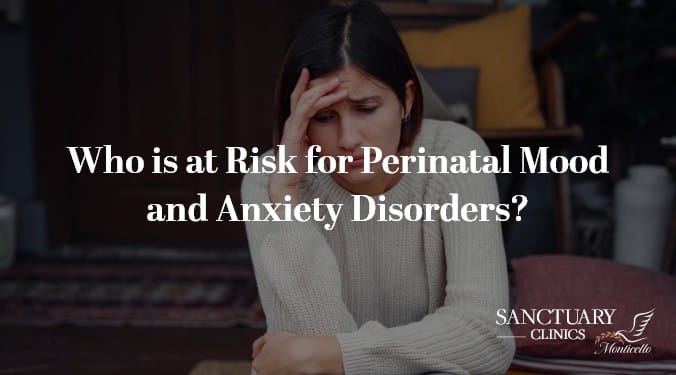Psychiatric disorders can be triggered or made worse by hormonal changes in women’s lives, which occur in pregnancy and the postpartum period. Perinatal mood disorders are related to mood and anxiety symptoms which occur during pregnancy or within one year after delivery. They are called postpartum mood and anxiety disorders (PMAD). Both mood and anxiety disorders can occur at the same time, increasing the severity of the illness.
Women at risk for PMAD include:
- – Women with current depression or anxiety
- – Women with a history of perinatal mood disorders
- – Women with suicidal thoughts
- – Women with risk factors for perinatal mood disorders
The above would need closer attention and may even need psychologic, psychosocial, or even pharmacologic therapy for perinatal depression.
In this article, we will discuss perinatal depression and anxiety.
Perinatal depression
Depression occurs more in women than men, and peaks among women within the reproductive ages. Perinatal depression includes both major and minor depressive episodes which occur during pregnancy or within the first 12 months after delivery.
Postpartum depression is a major and common complication, and hence needs to be identified and treated early to prevent detrimental effects. It has been shown to affect one in seven women. In fact, in 2011, 9% of pregnant women and 10% of postpartum women met the criteria for major depressive episodes. It has also been noted men can experience perinatal mood disorders by proxy: 10% of men who have a depressed partner also experience similar depressive symptoms.
Perinatal depression may go unnoticed as depressive symptoms such as changes in sleep, appetite, libido, fatigue, and stronger emotional reactions may be attributed to normal pregnancy and postpartum changes. Women also may be reluctant to report these mood changes, possibly due to fear of stigma.
Symptoms of perinatal depression
- Low mood or feeling sad and depressed
- Reduced interest in motherhood
- Feelings of worthlessness and guilt or feeling you’re not a good enough mother
- Sleep disturbances like insomnia and fatigue
- Suicidal thoughts
- Forgetfulness, indecisiveness, reduced attention
- Irritability
Difference between postpartum depression and baby blues
Around 50-80% of women have emotional changes after giving birth, where they feel physically and emotionally overwhelmed, have sleep disturbances, and feel now the baby is here, things will never be the same again. These are ‘baby blues’ and become concerning if they are prolonged for more than two weeks, and interfere with daily life activities. Then these symptoms could lead to postpartum depression.
Perinatal anxiety
Around 8-10% of pregnant women and 4-10% of postpartum women have anxiety disorders. Unfortunately, it often goes underdiagnosed as it is difficult to distinguish normal versus pathological worry.
Symptoms include:
- – Having perinatal worries; fears around fetal wellbeing, maternal wellness, illness in the partner, and fetal/child death
- – Feelings of fatigue, tension, concentration difficulties, and insomnia
- – Sexual dysfunction and distress due to sexual fear, avoidance, and increased self-consciousness over body image
A diagnosis is made if the above symptoms are disabling, recurrent, time-consuming, intrusive, and if the worries acquire a quality of irrationality. They meet the criteria if they last for more than one month.
Screening for perinatal depression and anxiety
Screening for perinatal depression should be performed at least once with a standardized tool for depression or anxiety symptoms. This can be done during pregnancy and a comprehensive post-partum check-up. Screening has some clinical benefits, as it allows for early identification of any patients with these disorders. However, following up to initiate treatment or refer to a mental health care provider is of greatest benefit.
A healthcare provider is encouraged to ask directly concerning mood changes as they could easily be missed. Ask her if she has anxiety, insomnia, or frightening thoughts. Also, ask if she can sleep when her infant is sleeping. It may be difficult for the patient to understand worry may represent an illness, as they may experience disbelief, embarrassment, or shame related to the emotional turmoil, and may have reduced insight due to mental dysfunction from the all-consuming worry.
Healthcare providers should be trained to offer a screening tool for depression and clinically correlate them with patients’ context. The screening tests include:
- Edinburgh Postnatal Depression Scale (EPDS
- Patient Health Questionnaire Nine
- Beck Depression Inventory
- Center for Epidemiologic Studies Depression Scale
Unfortunately, there is no perinatal-specific screening tool for anxiety disorders, hence early identification, diagnosis, and treatment are usually compromised. However, the General Health Questionnaire, State-Trait Anxiety Inventory, Hospital Anxiety, depression scales, and GAD-7 are in use.
Risk factors for perinatal mood and anxiety disorders
- Depression during pregnancy
- The anxiety of the mother
- Previous history of depression
- Lack of social support
- Unintended pregnancy
- Domestic violence
- Lower socioeconomic status
- Smoking
- Single mothers
- Maternal young age
- Life stress
Risk factors for postpartum mood and anxiety disorders
- Depression and anxiety during the pregnancy
- Stressful life events during the pregnancy or postpartum period
- Traumatic birth experiences
- Preterm delivery with their baby being admitted to the newborn intensive care unit
- (NICU)
- Low social support
- Previous history of depression
- Breastfeeding issues
Effect of perinatal mood and anxiety disorders on children
Maternal dysfunction impacts mother-infant bonding and can influence neurodevelopmental outcomes in children. This is because anxiety and depression in mothers lead to reduced responsiveness in their children. There are increased rates of preterm birth and low birth weight for the fetuses among mothers with PMAD. Neonatal babies may have more colic and have difficulties feeding due to depressed and anxious parents. Infants appear withdrawn and display a lower emotional tone.
Children of parents with depression or anxiety can have trouble developing language, attention, and behavior as they grow older. They may also lack parental support and attention, predisposing them to mood and anxiety disorders later in life.
Treatment of perinatal mood and anxiety disorders
Depending on the severity of the illness, different treatment strategies are employed. They include:
- Cognitive behavioral therapy
- Relaxation therapy
- Mindfulness
- Medications: Antidepressants like SSRIs are useful for both depression and anxiety, with benzodiazepines being used in the short term for anxiety. Pharmacotherapy is used alone or in combination with therapies for moderate to severe illnesses.
Psychoeducation also plays a vital part in overcoming denial/stigma and facilitating successful interventions.
Conclusion
Childbearing and birth have a great impact on your emotional wellbeing due to the hormonal, social, and overall life changes they bring. If you or your loved one has symptoms of perinatal mood and anxiety disorder, kindly seek help from a medical professional for support.
Sources
- ACOG Clinical guidance and committee opinion on screening for perinatal depression
- Lancaster CA, Gold KJ, Flynn HA, Yoo H, Marcus SM, Davis MM. Risk factors for depressive symptoms during pregnancy: a systematic review. Am J Obstet Gynecol 2010;202:5–14
- Robertson E, Grace S, Wallington T, Stewart DE. Antenatal risk factors for postpartum depression: a synthesis of recent literature. Gen Hosp Psychiatry 2004;26:289–95.








